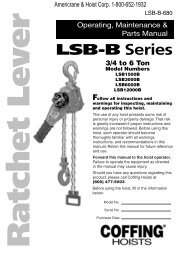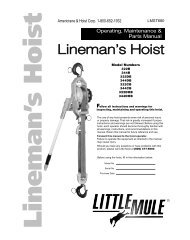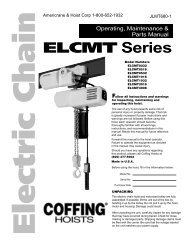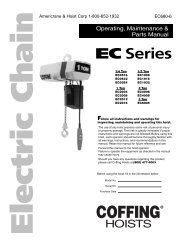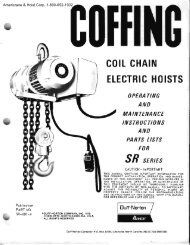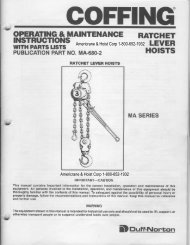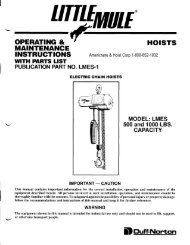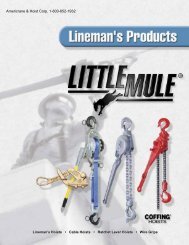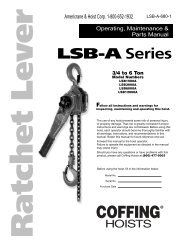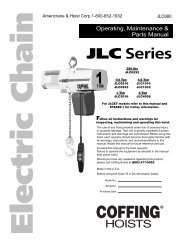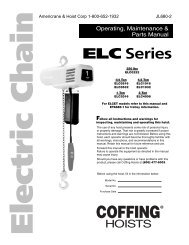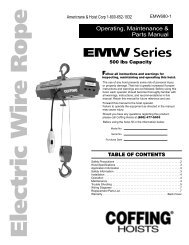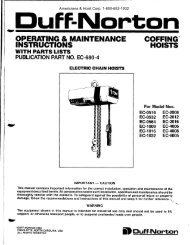Coffing Hoists - Binghamton Material Handling
Coffing Hoists - Binghamton Material Handling
Coffing Hoists - Binghamton Material Handling
You also want an ePaper? Increase the reach of your titles
YUMPU automatically turns print PDFs into web optimized ePapers that Google loves.
Hoist Capacity<br />
Determine the maximum load to be lifted.<br />
If the load falls between standard rated<br />
capacities, always select the higher capacity<br />
(i.e., for 4,300 lb. maximum load, use 6,000 lb.,<br />
or 3-ton capacity hoist).<br />
Hoist Lift<br />
To determine the total lift required, measure the<br />
distance from the bottom of the beam to the<br />
lowest point on the floor to be reached and<br />
subtract the hoist headroom dimension shown<br />
in the specifications. The remaining distance is<br />
the lift required on the hoist. Always select a<br />
standard lift equal to or greater than the distance.<br />
Duty Cycle<br />
Air motors inherently are self-cooling during<br />
operations. Unlike an electric motor which<br />
heats during operation, air motors are suitable<br />
for unlimited “on-time” and unlimited “number<br />
of starts”. <strong>Coffing</strong> ® CAH model air hoists are<br />
desirable for duty cycles demanding 100%<br />
“on-time”.<br />
Explosive Atmosphere<br />
Since air hoists operate on compressed air,<br />
there is no electrical arcing hazard to cause<br />
explosions in such areas as paint spraying and<br />
petrochemical facilities. For those hazardous<br />
atmosphere applications where resistance to<br />
friction sparks is vitally important, spark resistant<br />
models are available. Spark resistant features<br />
include: bronze alloy hooks, stainless steel hook<br />
latches, non-magnetic, stainless steel load chain;<br />
modified load sprocket, guide and stripper<br />
arrangement; and stainless steel or anodized<br />
aluminum lower blocks. Since stainless steel<br />
load chain is of lower strength than standard,<br />
CAH spark resistant models are de-rated in<br />
capacity.<br />
Control<br />
Normally, air hoists lift loads at a faster rate of<br />
speed than electric hoists. Additionally, air hoists<br />
have variable speed control to lift loads from creep<br />
speed to full speed. Applications requiring variable<br />
speed lifting for precise load spotting and smooth<br />
starting action should employ an air hoist. Also to<br />
be considered are pull cord or pendant throttle as<br />
the means for operator control of the hoist and load.<br />
Hoist Suspension<br />
<strong>Coffing</strong> ® CAH model air hoists can be offered in<br />
a wide variety of suspension options. Hook type<br />
suspension offer maximum versatility and portability<br />
in most environments. Lug suspensions save<br />
headroom and can be used with rigid mount<br />
trolleys or in permanently mounted locations.<br />
Trolley Type<br />
There are three standard trolley types that can be<br />
used to suspend <strong>Coffing</strong> ® CAH model air hoists.<br />
Push Trolley — Recommended for light capacities<br />
up to 2-tons and lifts below 20 feet.<br />
Most economical.<br />
Hand Geared Trolley — Offers precise control<br />
for load spotting. Most favorable for higher<br />
capacities, short monorails, and where lifts<br />
exceed 20 feet.<br />
Air Motor Driven Trolley — Most widely used<br />
method of suspension, particularly 2-ton capacity<br />
and above. Often a necessity where long<br />
monorails are used.<br />
Special Note<br />
The installation of every air hoist must include a<br />
filter and lubricator in the air line. An air regulator<br />
is also recommended.<br />
42



